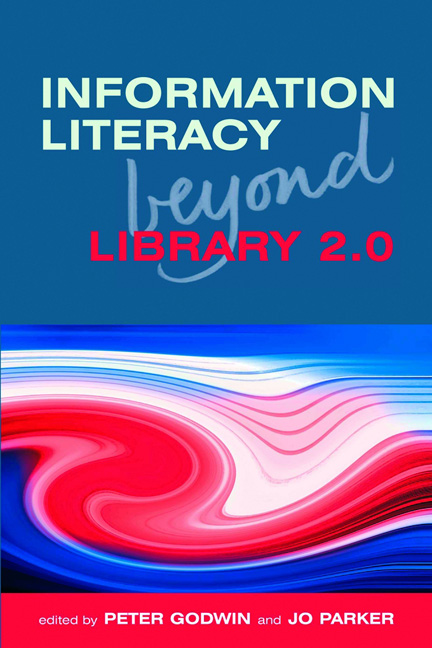Book contents
- Frontmatter
- Contents
- Contributors
- Acknowledgements
- Introduction
- PART 1 RECENT DEVELOPMENTS IN INFORMATION LITERACY AND LIBRARY 2.0
- PART 2 CASE STUDIES
- PART 3 WHAT IT MEANS FOR INFORMATION PROFESSIONALS
- 18 Helping the public online: Web 2.0 in UK public libraries
- 19 Change has arrived at an iSchool library near you
- 20 Information literacy: a path to the future
- 21 Thoughts about the future
- 22 Last word: information literacy beyond Library 2.0
- Index
19 - Change has arrived at an iSchool library near you
from PART 3 - WHAT IT MEANS FOR INFORMATION PROFESSIONALS
Published online by Cambridge University Press: 09 June 2018
- Frontmatter
- Contents
- Contributors
- Acknowledgements
- Introduction
- PART 1 RECENT DEVELOPMENTS IN INFORMATION LITERACY AND LIBRARY 2.0
- PART 2 CASE STUDIES
- PART 3 WHAT IT MEANS FOR INFORMATION PROFESSIONALS
- 18 Helping the public online: Web 2.0 in UK public libraries
- 19 Change has arrived at an iSchool library near you
- 20 Information literacy: a path to the future
- 21 Thoughts about the future
- 22 Last word: information literacy beyond Library 2.0
- Index
Summary
Introduction
Since the start of the third millennium, the educational services of a good school library have become more important than ever – this at a time when school librarians or teacher librarians have been warned of their irrelevance, with some school libraries also having been closed. At the centre of this misguided scenario are the changes brought about by technology and the digitization of our lives, online, on devices, in a variety of formats and in a socially networked world. Our students have been born into a digital era that is significantly changing their literacy and information encounters and the ways in which they can learn. Participative new media tools have altered the shape and experience of learning and provided school librarians in the changing learning environment with new skills, new tools and new ways of working with literacy, information literacy and digital fluency in Library 2.0 (O'Connell, 2008). The iPad and other mobile devices have changed school libraries forever. While we are not yet quite sure what the implications of these changes will be over the long term, the era of the iSchool library has definitely arrived. In the 21st century information ecology, the school library is evolving into a school-wide, future-oriented library service, sometimes described as the iCentre (Hough, 2011) or Learning Commons (Loertscher and Marcoux, 2010). In this new library, both physical and virtual spaces are being changed. Many schools (Corbett, 2011; Subel, 2007) have transformed the library's physical space into collaborative work areas or spaces for relaxation, designed for reading; information gathering, analysis and sharing; and media creation. With improved delivery of digital content for use in new flexible learning spaces, libraries are being purposefully designed to become active agents of learning.
Our students now need help in navigating diverse information pathways within their personal and creative learning environments. They need a range of literature and information options, delivered to them via a variety of physical and virtual means – from books to all manner of media and digital objects – via a plethora of digital devices. They need to know how to juxtapose text, sound, media and social connections in real time, and how to filter, then mix and match what they see, hear and experience in order to build personal knowledge and understandings of the curriculum.
- Type
- Chapter
- Information
- Information Literacy Beyond Library 2.0 , pp. 215 - 228Publisher: FacetPrint publication year: 2012



